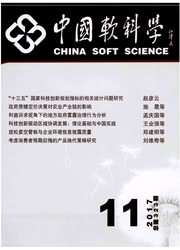

 中文摘要:
中文摘要:
基于Sen的可行能力理论,本文将因子分析模型、FGT指数和夏普利方法相结合,构建了福利贫困的变动分解框架。本文以2009年和2012年上海农民工数据为例,先对农民工福利贫困进行按功能性活动的水平分解,计算各功能性活动对福利贫困的贡献度,并揭示福利贫困的构成与类型;接着在变化分解中,福利贫困的变动将进一步被分解为功能性活动的增长成分、分配成分和贫困线变动成分。研究结果显示,(1)在沪农民工遭遇严峻的福利贫困问题,2009年和2012年农民工福利贫困发生率分别为29.10%和25.69%;(2)水平分解表明:福利缺失是造成农民工福利贫困的重要因素,而福利不均等对福利贫困的贡献度相对较小;变动分解表明:各功能性活动的增长成分在福利变化中起着更重要的作用;(3)分组分析显示:随着农民工教育程度的提高,福利贫困情况逐渐改善;随着年龄和进城时间的增加,农民工福利贫困状况呈现“u”变化;(4)功能性活动指标显示:对福利贫困贡献率最大的三个可行能力指标分别是可支配收入、歧视和保险。主要政策含义包括:促进农民工的自由发展和各项能力的获得是解决福利贫困问题的当务之急;提高可支配收入,消除歧视和扩大保险覆盖面是改善农民工福利贫困问题的有效手段。同时,努力提高农民工教育水平,加强职业技能培训,对年长者和进城时间较长者给予额外的关注和重视,均有利于改善农民工福利贫困状况。
 英文摘要:
英文摘要:
According to Sen's capability theory,this article intends to construct the variable decomposition framework by integrating factor analysis model,FGT index and Shapley method. This article takes the data of Shanghai migrant workers in 2009 and 2012 for instance ,and firstly decomposes welfare poverty of migrant workers in accordance with functional activltles,then calculates each functional activity's contribution to welfare poverty,thus disclosing the structure and type of welfare poverty. In the variable decomposition, the variation of welfare poverty will be further decomposed into growth component,distribution component and poverty line variation component. The research results indicate that ( 1 ) Migrant workers in Shanghai severely suffer from welfare poverty. The welfare poverty rates of the year 2009 and 2012 are as high as 29. 10% and 25. 69% respectively; (2)The static decomposition indicates that welfare loss is an important factor leading to the welfare poverty of migrant workers, whereas the welfare inequality contributes relatively little to the welfare poverty; the dynamic decomposition demonstrates that the growth component in each functional activity plays a more important role in the welfare variation. (3) Group analysis shows that with the improvement of migrant workers' educational degree, their welfare poverty is gradually improved. As the age and city living duration of migrant workers increase, their welfare poverty displays U-shaped change. (4) The indexes of functional activities indicate that three capability indexes which contribute the most share to welfare poverty are disposable income, discrimination and insurance respectively. Our findings provide policy implications on mitigating welfare poverty include : It takes a priority to facilitate the free development and overall competence of migrant workers; An effective method to improve the welfare poverty of migrant workers is to enhance their disposable income, eliminate discrimination and expand the coverage of
 同期刊论文项目
同期刊论文项目
 同项目期刊论文
同项目期刊论文
 期刊信息
期刊信息
